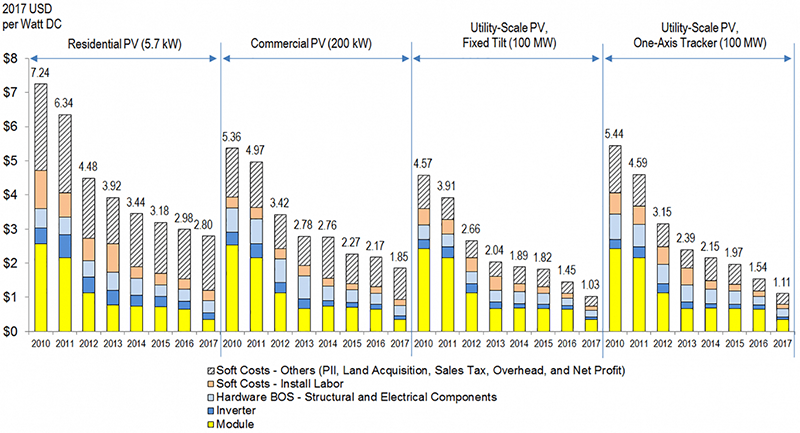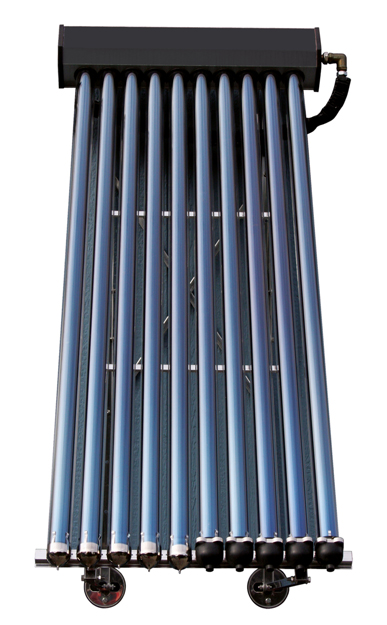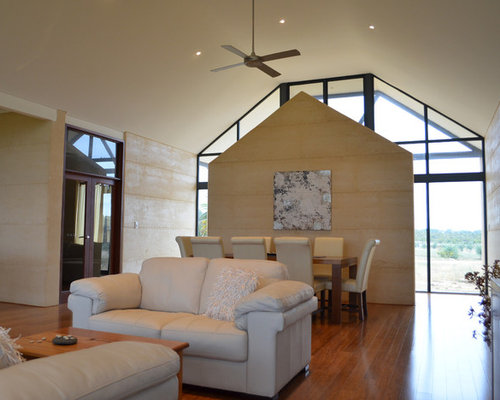Personal PV:
Solar Energy in Homes:
Of the various forms of solar energy generation the ones that make the most sense on a personal level are PV generation of electricity and various forms of low temperature heat capture. The heat capture can be active or passive which we will explore later.
The generation of electricity at a personal level with PV panels is made enormously more economical by the idea of net metering. Net metering is the concept that an individual is allowed to put energy back onto the grid (subject to safety standards) while running their meter backwards. This allows individuals to ignore the usual power management constraints about making power exactly when it is needed. This is currently a legal priviledge in many western states that may go away if the amount of solar energy generated by individuals begins to make a significant impact on the total power on the grid. Another benefit of running the meter backwards is that the individual is receiving full retail value for any energy they make which is a very good deal. Finally, because most solar energy is created in the summer, an individual can run their meter backwards during the summer to offset energy use during the winter.
Net metering was created in the late 70's as a tool for encouraging the early adoption of various solar electric generation technologies. While the utilities generally dislike it due to perceived difficulties in managing the unpredicatable addition of power to the grid thus far it has remained.
Worksheet Analysis:
These are the links and data that we will use to execute our analysis of installing a personal PV system on our homes.
One of the reasons I love this government agency is that they do things like this. We will walk through each section of this calculator to be sure you understand what it means and how it affects the overall decision making process.
Here is a link to the PersonalSolarPV Analysis worksheet we use in the class to track this exercise.
1: Choose an address. This allows the calculator to look up weather and other solar data that affects the output of your proposed system. They have recently upgraded this calculator to allow consideration of PV installations around the world -- very cool. Having this look up means that you don't have to worry about weather variables or location on the globe. Select GO...
The next page will ask you to confirm the solar resource data to use. You may or may not have choices. Select Go when ready...
2: System Information
DC system size:
This is the first big decision in your model because it affects costs as well as energy production. You can of course go look up current costs but this is more complex than it looks because there are multiple systems you need to purchase and install. Here is a link to the 2017 installed cost analysis paper from NREL and I include the plot below as a quick reference guide. NREL is likely to update this from time to time so search their website for the most current version of this document. (in 2020 the updated version of this plot is from 2018 and is not significantly different!)

Based on this and a rough budget you can determine a plausible size of your installation. The image below with 12 panels is probably a 7 kW system.

Module Type:
This decision is really about the overall efficiency of the PV panel. Standard is currently 15% but you can get better (Premium) or cheaper but lower efficiency (thin film). I think the Elon Musk proposed roof tiles are thin film.
Array Type:
In Central Oregon we would mostly choose open rack systems (roof or ground) or roof mount systems. The open rack system allows you to choose the angle of the panels independent of roof angle. Slightly more expensive and exposed to wind damage. Roof mounts are slightly hotter which reduces efficiency (taken care of in the calculator software). Tracking mounts are high end and unlikely for most folks. Tracking would typically matter if you're off grid and need every scrap of energy generation.
System Losses:
Lots of things that we have talked about can affect the performance of our system from shading to wind blown dirt or overheating. You can adjust these if you want with the calculator or just accept the generic 14% loss for now.
Tilt:
This allows you to explore different configurations of your panel installation. If your panels are mounted parallel to your roof then your roof determines the tilt (see the information button for more input). In an open rack system you can choose the tilt angle. Tilted at the latitude of your location gives good average performance. More vertical installations give better winter time performance but generate much less energy overall. More horizontal installations generate more energy overall because they are optimized for summer sun and longer days. Explore and see what happens.
Azimuth:
Azimuth is the direction the panels point along the horizon. Again, the generic solution is to point them straight south which is 180 degree (from north). If we lived in a place where morning fog was normal or lots of late afternoon western clouds were common we might change this a little but I say we go with 180 degrees for starters.
Advanced Parameters:
There are good explanations for these but we won't consider them for openers.
System type:
We're looking at residential installations which currently have no federal tax benefits though there are still some state benefits. Visit Energy Trust of Oregon to find out the most current tax benefits or credits.
Average Cost of Electricity:
We have been using $0.10/kWh because it is easy to calculate with. If you look at Pacific Power's Residential Price comparison it appears that our average cost of electricity is about $0.112/kWh.
Results Page:
I love that they give you a month by month predicted generation as well as a range of totals. Remember that an average Oregonian uses about 1000 kWh/month through the cooler times of year and maybe a bit less in the summer. Think about how the estimated output of your array compares with your monthly usage.
Payback Time:
Assuming you paid cash up front what is the payback time on your proposed system? The first break point in your thinking should be around 10 yrs. Less than 10 year payback is not bad for a personal system. More than 20 years is not a happy place.
Do you want to go back and change some numbers? I sure do.....
HW: Solar Personal
Turn in your completed worksheet with your assessment of whether you think you might make this investment some day.
Solar Hot Water:
What information do we need to figure out what might make sense for using the sun to heat hot water for ourselves? Let's make a general flowchart of the information that might be handy and see how good I did at predicting what information you might want:)
Different Systems:
I'm not recommending any particular vendor. This page describing different systems and where they are most effective seems like a useful starting point. If you want to dig deeper here is a Solar Hot Water analysis from NREL.
Here are some terms you might wonder about after you look at these documents:
Active Systems: The fluids being heated by the sun are moved from place to place with pumps and valves.
Open Loop Systems: These are systems where the fluid being heated is the actual water you use.
Closed Loop Systems: These systems where the fluid being heated is stored and used to heat the water you actually use. The primary reason for this is the risk of freezing. Closed loop systems can circulate anti-freeze treated fluids through the panels without contaminating your domestic water.
System Cost: Sample System
Panel Efficiency: We'll have to figure out typical efficiencies from this table from the wiki page. This will take us a little while. Why is it difficult to quote an efficiency for such a panel? What are the many variables that might affect efficiency?
Finally found a spec sheet for one of the ones in the sample system. AE Panel Performance Specs
Energy Collected: We need to know both the energy falling on a panel here in Central Oregon and then we'll need to figure out, from the efficiency, how much we get to keep. We'll have to hope other system losses are small.
Payback Time: We should now be able to figure out the simple payback time.
It doesn't seem excessively enthusiastic to imagine that we might generate 15 kWh of energy each day from this two panel system here in Central Oregon. That's about $1.60/day which would make the payback time for a $5000 system 3125 days ($5000/$1.60) which is 8.5 years. Some of you will consider that you might be able to build such a system for substantially less than $5000 and you would be correct in that. If you have the skills here is the resource I would recommend for guidance -- builditsolar.com is based in Montana so they know cold weather and they do actual science and engineering tests of their designs. Good folks!
Energy Trust and Federal Rebates: The link takes you to the actual federal tax form which is no fun. It appears that solar hot water qualifies for a 30% rebate in general. It does not appear that Energy Trust offers any direct incentives at this time. How much shorter is the payback time with the federal rebate if you qualify for it?
Another Perspective: Here is a link to an analysis of solar hot water systems by a Stanford student, Alex Contryman, for one of his physics classes.
HW: Solar Personal
Given the efficiencies listed on this wiki table active flat panel systems how many square meters of solar panel would you need to have to provide for your daily hot water needs (12 kWh/day) when you are receiving 100 W/m2 of sunshine on a winter day in Central Oregon? How many square meters would you need on a summer day when the sunshine is delivering energy at 300 W/m2?
Evacuated Tubes:
One feature of most solar hot water systems is that they don't create tremendously hot water. Evacuated Tube collectors use a physics principle that also exists in your refrigerator to use solar energy to heat water to much higher temperatures (130 F or more). These systems are definitely more expensive but if you need hotter water it's a way to get it. The place you see these around Central Oregon is on some car washes where hot water is their primary expense.

The individual tubes can be replaced if need be.
Solar Hot Air:
You could figure these out the same way but I would recommend reading the thoughtful information on this site testing/comparing different DIY solar systems (also from the builditsolar crew) and see what you think. We will discuss what the considerations are in class.
As a quick example consider this very basic solar hot air panel which purports to generate 10 kWh/day and costs about $2000. By now you can practically do the math in your head to see that the payback time is 2000 days which is about 5.5 years. Again, if you have basic skills, you can easily imagine building one of these systems for half the price.
Trombe Walls:
Another system I'd like to explore with you is called a Trombe wall. This is essentially a solar hot air system that also contains a large thermal mass to extend the effectiveness of the system into the evenings. A version of this you may have heard of is placing many black milk jugs of water in the back of your greenhouse to keep it from freezing on cold nights. NREL has done lots of analysis of various Trombe wall projects including these two short overviews: Trombe I, Trombe II
This particular example (from Australia I think) has a large rammed earth wall (stone essentially) in front of the window. Plenty of sunshine comes around the wall to light the room and the rest slowly heats the stone slab through the day. At night, when it cools down, the stone slab releases the heat it has stored all day keeping the room comfortable well into the night. Such a system also works in reverse as an air conditioner if the nights are cold in the summer as they are here. How would that work?

Assignment: HW: Solar Personal
Complete and assemble your solutions to all the HW problems (2) listed here showing all the steps in your solutions. Scan to a pdf and turn in on LMS. Please review HW format expectations for guidance about your homework solutions.of
Reading Ahead:
Next you will read the Can We Do It? chapter from David's book before we start the next discussion. There are some important features of this chapter that we need to discuss even though it seems more certain that the US has the potential to meet it's energy needs with renewable energy sources.
